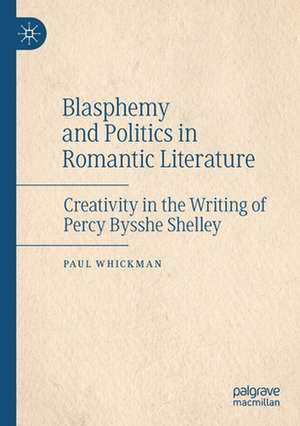Blasphemy and Politics in Romantic Literature: Creativity in the Writing of Percy Bysshe Shelley
Autor Paul Whickmanen Limba Engleză Paperback – 8 iun 2021
This book argues for the importance of blasphemy in shaping the literature and readership of Percy Bysshe Shelley and of the Romantic period more broadly. Not only are perceptions of blasphemy taken to be inextricable from politics, this book also argues for blasphemous ‘irreverence’ as both inspiring and necessitating new poetic creativity. The book reveals the intersection of blasphemy, censorship and literary property throughout the ‘Long Eighteenth Century’, attesting to the effect of this connection on Shelley’s poetry more specifically. Paul Whickman notes how Shelley’s perceived blasphemy determined the nature and readership of his published works through censorship and literary piracy. Simultaneously, Whickman crucially shows that aesthetics, content and the printed form of the physical text are interconnected and that Shelley’s political and philosophical views manifest themselves in his writing both formally and thematically.
| Toate formatele și edițiile | Preț | Express |
|---|---|---|
| Paperback (1) | 383.12 lei 6-8 săpt. | |
| Springer International Publishing – 8 iun 2021 | 383.12 lei 6-8 săpt. | |
| Hardback (1) | 387.75 lei 6-8 săpt. | |
| Springer International Publishing – 7 iun 2020 | 387.75 lei 6-8 săpt. |
Preț: 383.12 lei
Nou
Puncte Express: 575
Preț estimativ în valută:
73.31€ • 76.70$ • 60.90£
73.31€ • 76.70$ • 60.90£
Carte tipărită la comandă
Livrare economică 02-16 aprilie
Preluare comenzi: 021 569.72.76
Specificații
ISBN-13: 9783030465728
ISBN-10: 3030465721
Pagini: 212
Ilustrații: X, 212 p. 1 illus.
Dimensiuni: 148 x 210 mm
Greutate: 0.3 kg
Ediția:1st ed. 2020
Editura: Springer International Publishing
Colecția Palgrave Macmillan
Locul publicării:Cham, Switzerland
ISBN-10: 3030465721
Pagini: 212
Ilustrații: X, 212 p. 1 illus.
Dimensiuni: 148 x 210 mm
Greutate: 0.3 kg
Ediția:1st ed. 2020
Editura: Springer International Publishing
Colecția Palgrave Macmillan
Locul publicării:Cham, Switzerland
Cuprins
1. Introduction.- 2. Chapter 2: Blasphemy and Copyright in the Long Eighteenth Century, 1695-1823.- 3. Chapter 3: Blasphemy and the Shelley Canon: Queen Mab and Laon and Cythna.- 4. Chapter 4: Vulgar Anthropomorphisms: Blasphemy, Power and the Philosophy of Language.- 5. Chapter 5: The Promethean Conqueror, the Galilean Serpent and the Jacobin Jesus: Shelley's Interpretation(s) of Jesus Christ.- 6. Conclusion.
Notă biografică
Paul Whickman is Senior Lecturer in English at the University of Derby, UK. Paul’s research interests lie in the Romantic period, particularly the work of Byron, Shelley and Keats. He has published in journals such as the Keats-Shelley Review and was previously a contributor to the Year’s Work in English Studies (2015-2018).
Textul de pe ultima copertă
This book argues for the importance of blasphemy in shaping the literature and readership of Percy Bysshe Shelley and of the Romantic period more broadly. Not only are perceptions of blasphemy taken to be inextricable from politics, this book also argues for blasphemous ‘irreverence’ as both inspiring and necessitating new poetic creativity. The book reveals the intersection of blasphemy, censorship and literary property throughout the ‘Long Eighteenth Century’, attesting to the effect of this connection on Shelley’s poetry more specifically. Paul Whickman notes how Shelley’s perceived blasphemy determined the nature and readership of his published works through censorship and literary piracy. Simultaneously, Whickman crucially shows that aesthetics, content and the printed form of the physical text are interconnected and that Shelley’s political and philosophical views manifest themselves in his writing both formally and thematically.
Caracteristici
Emphasizes the significance of religious thought in influencing the philosophy and aesthetics of Romanticism Traces the philosophical development within Shelley’s oeuvre and throughout his career Contributes to the study of censorship and religious attitudes within the long eighteenth century
